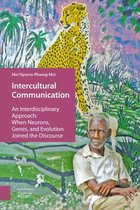Intercultural Communication Year 1
Table of Contents
Chapter 1 - The Survival of the Most Cultured ....................................................................................... 2
Chapter 3 - a necessary evil .................................................................................................................... 9
Chapter 6 - Intercultural Competence - Creating Yourself ................................................................... 16
Chapter 2 - The Evolving Culture .......................................................................................................... 21
Ch a p t e r 7 - D i v e r s i t y m a n a g e m e n t a n d I n c l u s i o n .............................................. 27
Chapter 4 - Non-verbal Communication - how you make them feel.................................................... 32
Chapter 5 - A Taxonomy Of Diversity .................................................................................................... 41
,Chapter 1 - The Survival of the Most Cultured
The nature of culture
According to Pagel our world is 4.5 billion years old, but culture appeared only around
200,000 years ago, with the ability to learn from others. It started with symbolic thinking in
the form of art and adornment, which allowed us to communicate ideas to others through
the meanings attached to each object or symbol.
Cultural diversity is crucial because it is a regulator for
a. safeguarding cultural resources, recognizing who we can trust
b. negotiating cultural resources with other human groups for mutual interests.
Effective resource management can lead to both the dividing and merging of cultures.
• A Power Transition from Gene to Culture
---- Genes or Culture?
For humans, the reverse is true, their genes give way to the social environment.
---- Culture as a Survival Strategy
We are much less dependent on our genes to tell us what to do. Instead of taking
information from the pool of DNA that we inherit from our parents, we gain most of our
survival information from culture: the food we
eat, the clothes we wear, the tools we make and use, the language we speak, the Gods we
believe in, the people we consider as friends and the enemies we should fight and kill in a
war. Basically, all human beings are born with a receptive mind that absorbs the first culture
seen; consequently, humans become actors in that culture.
• How Did This Power Transition Happen?
According to Pagel, our world is 4.5 billion years old, but culture appeared only around
200,000 years ago, with the ability to learn from others. It started with symbolic thinking in
the form of art and adornment, which allowed us to communicate ideas to others through
the meanings attached to each object or symbol. The ability to observe, copy, pick the best
practices, and transfer them to others created an entirely new sphere of evolution.
Culture is initially formed by the ability to imitate, to select the best practices, and to
transfer them to others. Instead of waiting for a change in genes so humans can evolve
wings to fly (which may never happen), culture allows us to pull ideas together and build air
planes.
Cultural diversity
Language is one of the defining traits of being humans, but it also means that we are
probably the only animal that can find itself in a situation where two individuals might not
be able to communicate with each
,other, as if they were two different biological species. Even when we seem to speak the
same language, different accents can make mutual understanding challenging.
• The Interaction of Environment – Culture
The biodiversity on our planet is impressive, and humans have used the capacity of culture
to be able to live in all kinds of environment. “biodiversity” is often used as a hypothesis to
explain the “cultural diversity” among humans.
---- Environmental Determinism
Environmental Determinism - living environment is the major reason why our societies
developed in different ways. The natural environment has long been used to explain
people's characters. How the physical environment predisposes societies and states towards
particular development trajectories.
Neo-Environmental Determinism - focused on the impact of enviornment on economic
and political development.
---- Environmental Possibilism
Environmental Possibilism - human beings are active rather than passive agents, who
see numerous possibilites in anture and actively shape it to suit our need for survival.
Probabilism - a mid-wat view that sees physical environment not as deterministic, but as
the most influential factor.
---- Cultural Ecology
The most important tenet of cultural ecology is that humans are part of the
enrionment, instrisically embedded in earh surface processes, neither "victims" of its force
(determinism), not an outside force making an impact on it (possibilism). <- culture is not a
"consequence" of nature or a tool to "control" nature, but rather a strategy to interact with
nature.
• Cultural Diversity as a Tool for Resource
Management
The desire to manage cultural resources not only enables diverse languages to evolve, but
also channels people into different sub-groups. As we band together to exert our authority
over certain resources in competition with another group, cultural diversity becomes an
element for us to recognize an ingroup we can trust.
Cultural diversity can be explained by:
• The impact of environment, with theories ranging from a deciding factor
(determinism), an influential factor (probabilism), a source of possibilities (possibilism),
to an entity inseparable from the human species (ecology).
• The role of linguistic and cultural diversity, which are regulators for:
1. safeguarding cultural resources, recognizing who we can trust
, 2. negotiating cultural resources with other human groups for mutual interests.
Diversity pathways
The interaction between environment and culture is dynamic, but it is far from sufficient in
terms of explaining human diversity. The complexity of our culture must be seen from a
bigger angle, one that involves the physical and genetic make-up of our body.
• The Interaction of Environment – Culture –
Genes
Genes are the fundamental physical and functional unit of heredity. Therefore, the power
transition from genes to culture is not mutually exclusive. Genes are crucial mechanisms for
turning useful cultural values
into genetic traits, and vice versa.
Gene-culture co-evolution theory: while culture shapes the expression and selection
of genes, genes also influence the adoption and formation of certain cultural values. Nature
and nurture are both active in shaping the diversity of human cultures and behaviors.
it can be problematic to structure our understanding along the traditional binary spectrum
of nature–nurtured opposites.
What has been culturally “nurtured” for long enough (group mindset) will slowly become
“nature” with genetic traits (depression gene). In turn, nature with genetic traits (depression
gene) reinforces those behaviors that are part of the culture (group mindset). This dynamic
interaction aims at the ultimate goal of evolving a culture that provides a survival strategy
that allows humans to advance.
• The Interaction of Environment – Culture –
Genes – Brain
---- Culture’s Influences on the Brain
Brains across different cultures and contexts do not work in the same way as the neural
funcitons are shaped by culture and social experience.






